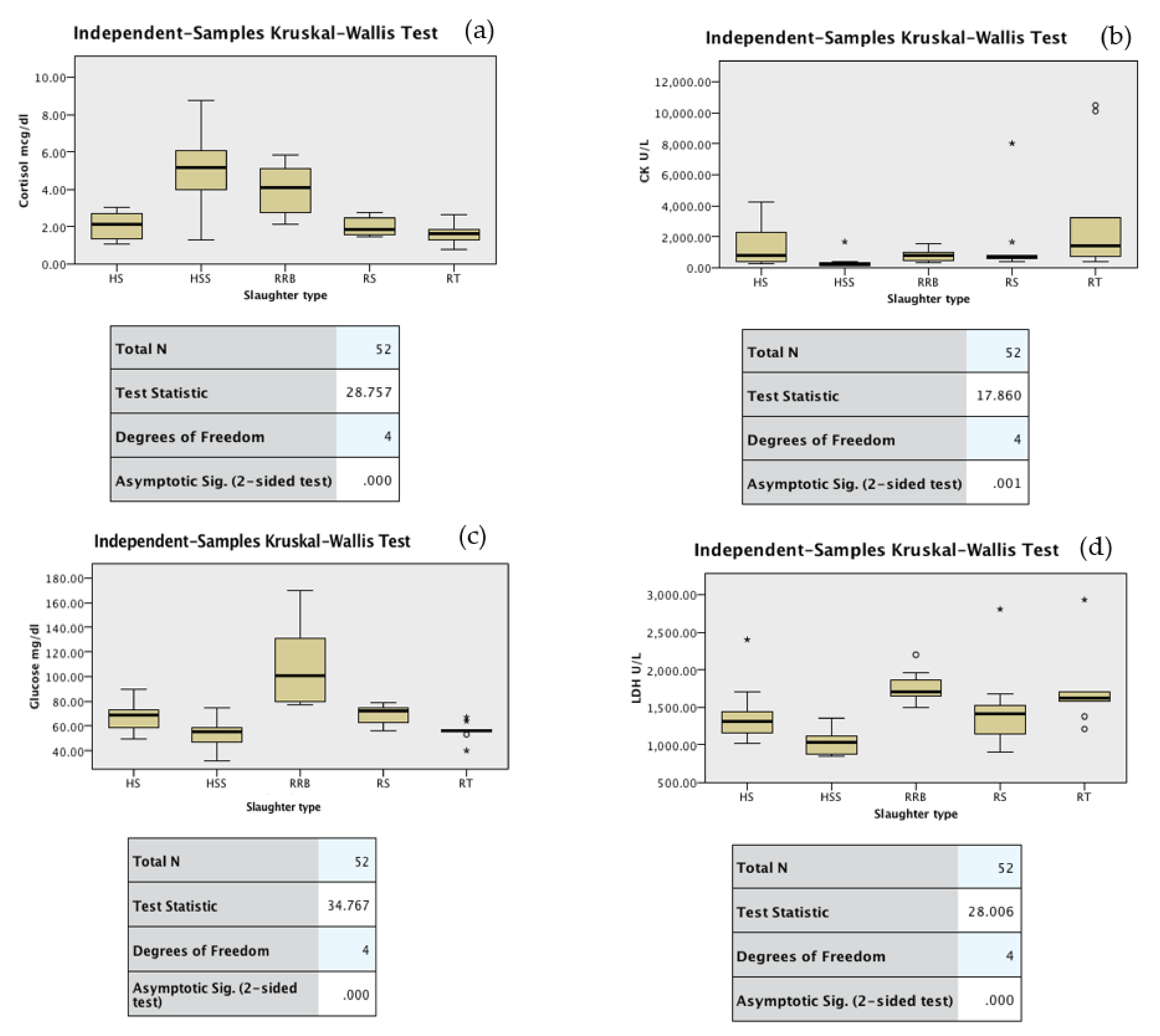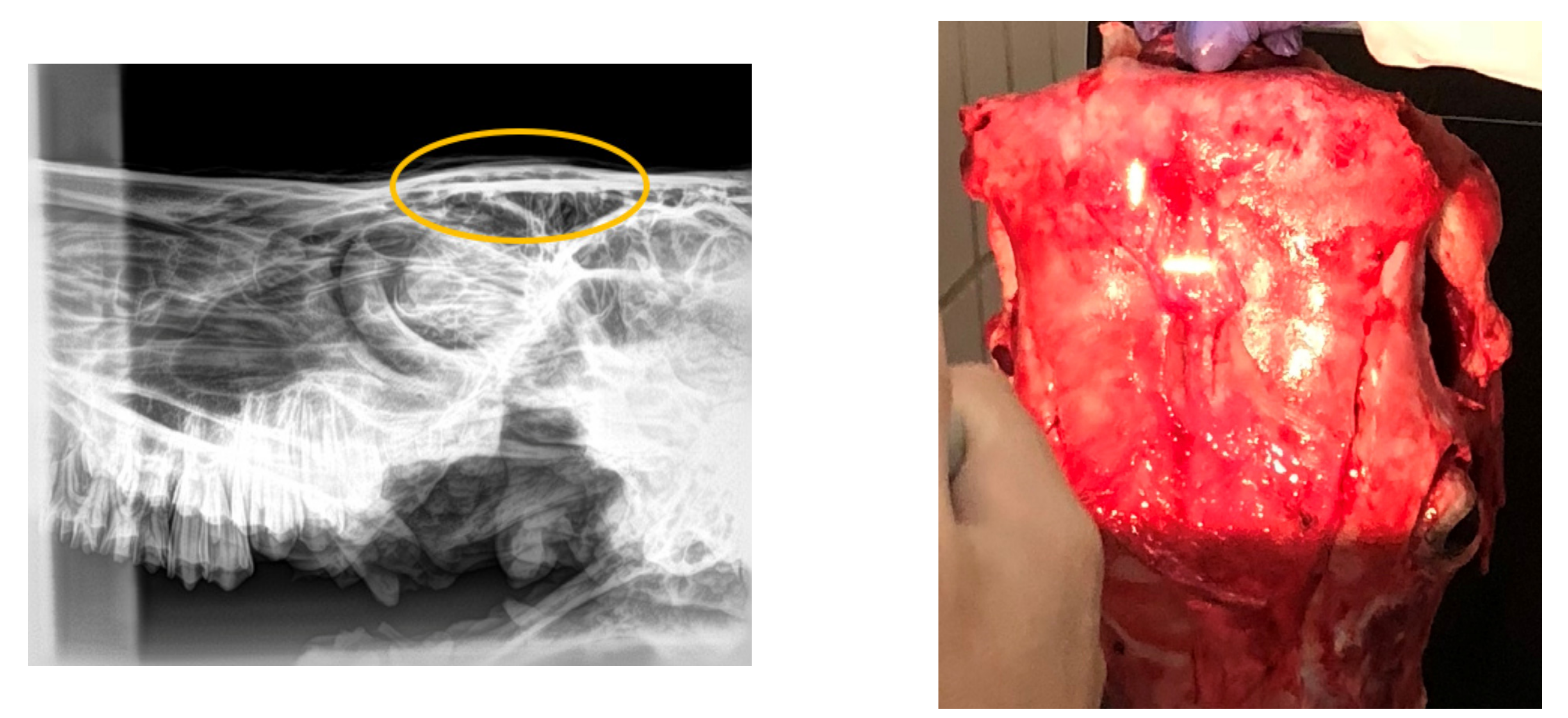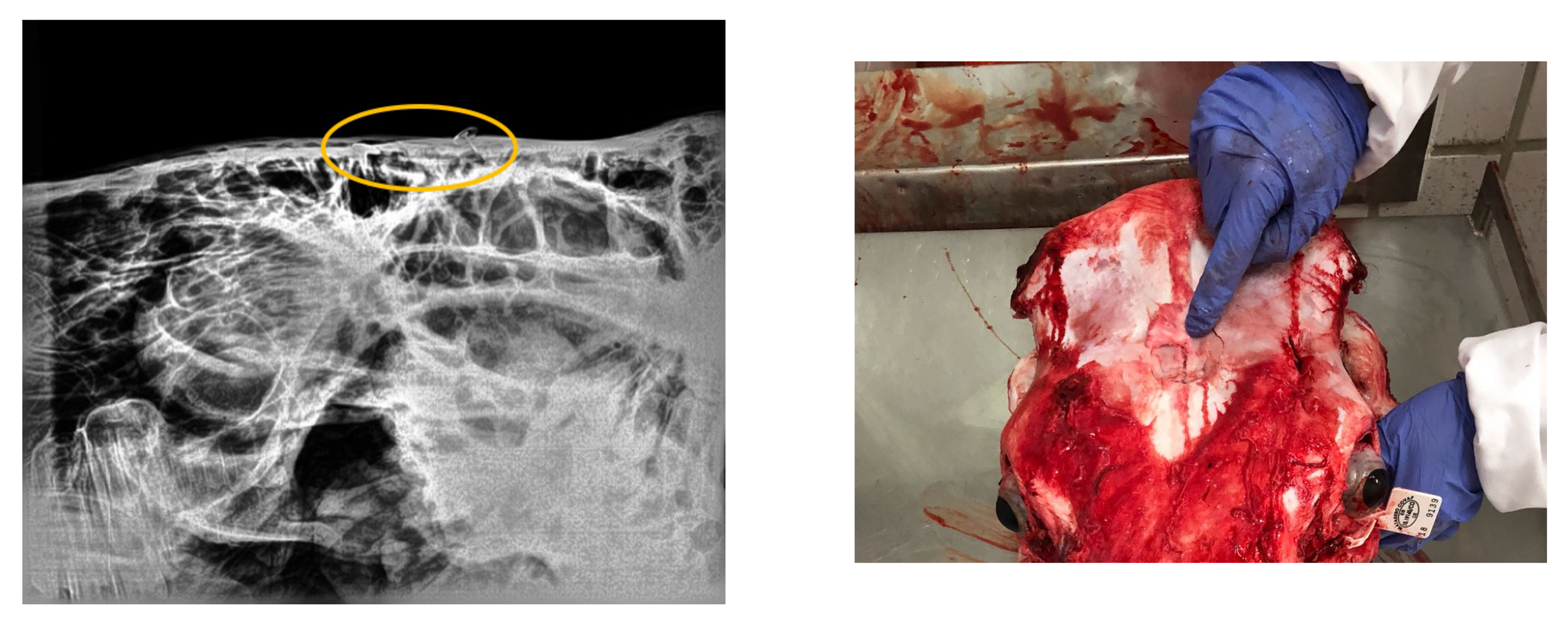Influence of the Slaughter Method on the Hygienic Quality of Beef Cattle Meat and Animal Welfare Biomarkers
Abstract
Simple Summary
Abstract
1. Introduction
2. Materials and Methods
2.1. Sampling and Slaughtering Conditions
2.2. Microbiological Analysis
2.3. Physiological Parameters Determinations
2.4. Methodology of Radiographic Study
2.5. Statistical Analysis
3. Results
4. Discussion
5. Conclusions
Author Contributions
Funding
Institutional Review Board Statement
Informed Consent Statement
Data Availability Statement
Acknowledgments
Conflicts of Interest
References
- Fraser, D.; Weary, D.M.; Pajor, E.A.; Milligan, B.N. A scientific conception of animal welfare that reflects ethical concerns. Anim. Welf. 1997, 6, 187–205. [Google Scholar] [CrossRef]
- Council Regulation (EC) No 1099/2009 of 24 September 2009 on the Protection of Animals at the Time of Killing. DOUE-L-2009-82167. Available online: https://eur-lex.europa.eu/LexUriServ/LexUriServ.do?uri=OJ:L:2009:303:0001:0030:EN:PDF (accessed on 17 January 2023).
- Al-Mahmood, O.A. Microbiological Safety of Halal Beef in the United States. Ph.D. Thesis, Clemson University, Clemson, SC, USA, 2020. Available online: https://tigerprints.clemson.edu/all_dissertations/2574 (accessed on 20 November 2022).
- Chandia, M.; Soon, J.M. The variations in religious and legal understandings on halal slaughter. Br. Food J. 2018, 120, 714–730. [Google Scholar] [CrossRef]
- Schuzle, W.; Schultze-Petzold, H.; Hazem, A.S.; Gross, R. Objectivization of pain and consciousness in the conventional (dart-gun anesthesia) as well as in ritual (kosher incision) slaughter of sheep and calf. Dtsch. Tieraeztliche Wodenschrift 1978, 85, 62–66. [Google Scholar]
- Pouillaude-Bardon, M.T. L’abattage Rituel en France. Ph.D. Thesis, L’Ecole Nationale Vétérinaire de Toulouse, Toulouse, France, 1992. [Google Scholar]
- Fuseini, A.; Wotton, S.B.; Knowles, T.G.; Hadley, P.J. Halal Meat Fraud and Safety Issues in the UK: A Review in the Context of the European Union. Food Ethics 2017, 1, 127–142. [Google Scholar] [CrossRef]
- Ali, A.M.; Abdalla, H.O.; Mahgoub, I.M. Effect of slaughtering method on the keeping quality of broiler chickens’ meat. Egypt Poult. Sci. 2011, 31, 727–736. [Google Scholar]
- Nakyinsige, K.; Fatimah, A.B.; Aghwan, Z.A.; Zulkifli, I.; Goh, Y.M.; Sazili, A.Q. Bleeding efficiency & meat oxidative stability & microbiological quality of New Zealand white rabbits subjected to halal slaughter without stunning and gas stun-killing. Asian-Australas. J. Anim. Sci. 2014, 27, 406–413. [Google Scholar] [CrossRef]
- Khalid, R.; Knowles, T.G.; Wotton, S.B. A comparison of blood loss during the halal slaughter of lambs following traditional religious slaughter without stunning, electric head-only stunning & post-cut electric head-only stunning. Meat Sci. 2015, 110, 15–23. [Google Scholar] [CrossRef]
- Anil, M.H.; Yesilderet, T.; Aksut, H.; Maturt, E.; McKinstryt, J.L.; Weavert, H.R.; Erdogan, O.; Hughes, S.; Mason, C. Comparison of halal slaughter with captive bolt stunning & neck cutting in cattle: Exsanguination & quality parameters. Anim. Welf. 2006, 15, 325–330. [Google Scholar]
- Gomes Neves, J.E.; Paranhos da Costa, M.J.R.; Roca, R.; Gregory, N.G.; Faucitano, L. Comparison of slaughter methods with or without previous stunning on animal welfare and bleeding efficiency in bulls. J. Anim. Sci. 2009, 87 (Suppl. S2), 6. [Google Scholar]
- Amilien, V.; Kjærnes, U. The dynamics of sheep welfare in Norway—Between idealised images and practical realities. Br. Food J. 2017, 119, 952–966. [Google Scholar] [CrossRef]
- Agüera, E.I. Nuevas Estrategias para la Protección y el Bienestar Animal. Sesión de Investidura como Académica en Real Academia de Ciencias Veterinarias de Andalucía Oriental. Libro An. 2013, 26, 11–22. [Google Scholar]
- Tadich, N.; Gallo, C.; Bustamante, H.; Schwerter, M.; van Schaik, G. Effects of transport and lairage time on some blood constituents of Friesian-cross steers in Chile. Livest. Prod. Sci. 2005, 93, 223–233. [Google Scholar] [CrossRef]
- Pighin, D.; Davies, P.; Grigioni, G.; Pazos, A.; Ceconi, I.; Mendez, D.; Buffarini, M.; Sancho, A.; Gonzalez, C. Effect of slaughter handling conditions and animal temperament on bovine meat quality markers. Arch. Zootec. 2013, 62, 399–409. [Google Scholar] [CrossRef]
- Averós, X.; Martín, S.; Riu, M.; Serratosa, J.; Gosálvez, L. Stress response of extensively reared young bulls being transported to growing-finishing farms under Spanish summer commercial conditions. Livest. Sci. 2008, 119, 174–182. [Google Scholar] [CrossRef]
- Bourguet, C.; Deiss, V.; Gobert, M.; Durand, D.; Boissy, A.; Terlouw, E. Characterising the emotional reactivity of cows to understand. Appl. Anim. Behav. Sci. 2010, 125, 9–21. [Google Scholar] [CrossRef]
- Alende, M.; Volpi Lagreca, G.; Pordomingo, A.J.; Pighín, D.; Grigioni, G.; Carduza, F.; Pazos, A.; Babinec, F.; Sancho, A.M. Efectos del tiempo de transporte, espera pre-faena y maduración en novillos sobre indicadores de estrés, calidad instrumental y sensorial de la carne. Arch. Med. Vet. 2014, 46, 217–227. [Google Scholar] [CrossRef]
- Mota, D.; Velarde, A.; Huertas, S.; Cajiao, M.N. Bienestar Animal. Una Visión Global en Iberoamérica, 3rd ed.; Elsevier: Barcelona, Spain, 2016. [Google Scholar]
- Llonch, P.; King, E.; Clarke, K.; Downes, J.; Green, L. A systematic review of animal-based indicators of sheep welfare on farm, at market and during transport, and qualitative appraisal of their validity and feasibility for use in UK abattoirs. Vet. J. 2015, 206, 289–297. [Google Scholar] [CrossRef]
- MS 1500:2009; Malaysian Protocol for the Halal Meat and Poultry Productions. Department of Standards Malaysia: Cyberjaya, Malaysia, 2009.
- Gregory, N.G.; von Wenzlawowicz, M.; Alam, R.M.; Anil, H.M.; Yeşildere, T.; Silva-Fletcher, A. False aneurysms in carotid arteries of cattle and water buffalo during shechita and halal slaughter. Meat Sci. 2008, 79, 285–288. [Google Scholar] [CrossRef]
- Strappini, A.; Metz, J.; Gallo, C.; Kemp, B. Origin, and assessment of bruises in beef cattle at slaughter. Animal 2009, 3, 728–736. [Google Scholar] [CrossRef]
- De Oliveira Roca, O. Humane slaughter of bovine. In Proceedings of the Embrapa: First Virtual Global Conference on Organic Beef–Cattle Production, Via Internet, 2 September–15 October 2002; University of Contestado - UnC - Concordia Unit - Concordia - SC - Brazil. Available online: https://www.semanticscholar.org/paper/Via-Internet-HUMANE-SLAUGHTER-OF-BOVINE-Ro%C3%A7a/8961c1a749883c7d0dc912ba6e8a36c44a975e70 (accessed on 17 January 2023).
- Red Meat Abattoir Association (RMAA). Animal Handling Practical Guidelines for Abattoirs. Available online: http://www.rmaa.co.za/2011/conference/AnimalHandlingSPCAforCongress201105.05.2011 (accessed on 6 October 2022).
- Grandin, T. Observations of cattle restraint devices for stunning & slaughtering. Anim. Welf. 1992, 1, 85–91. [Google Scholar]
- Hayes, N.S.; Schwartz, C.A.; Phelps, K.J.; Borowicz, P.; Maddock-Carlin, K.R.; Maddock, R.J. The relationship between pre-harvest stress and the carcass characteristics of beef heifers that qualified for kosher designation. Meat Sci. 2015, 100, 134–138. [Google Scholar] [CrossRef] [PubMed]
- Sabow, A.B.; Sazili, A.Q.; Zulkifli, I.; Goh, Y.M.; Ab Kadir, M.Z.A.; Abdulla, N.R.; Nakyinsige, K.; Kaka, U.; Adeyemi, K.D. A comparison of bleeding efficiency, microbiological quality and lipid oxidation in goats subjected to conscious halal slaughter and slaughter following minimal anesthesia. Meat Sci. 2015, 104, 78–84. [Google Scholar] [CrossRef]
- Warriss, P.D. Meat Science: An Introductory Text, 2nd ed.; CAB International: Wallingford, UK, 2001. [Google Scholar]
- Kallweit, E.; Ellendorf, F.; Daly, C.; Smidt, D. Physiologic reactions during the slaughter of cattle and sheep with and without stunning. Dtsch. Tierärztliche Wochenschr. 1989, 96, 89–92. [Google Scholar]
- Farouk, M.M.; Pufpaff, K.M.; Amir, M. Industrial halal meat production and animal welfare: A review. Meat Sci. 2016, 120, 60–70. [Google Scholar] [CrossRef] [PubMed]
- Rahmani, K. Jadeed Fiqhi Masail. In Kutub Khana Na′eemiyah; Deoband, India, 1998; Volume 1, 270–271. Available online: https://link.springer.com/chapter/10.1007/978-981-19-2619-8_4 (accessed on 17 January 2023).
- Grandin, T. Auditing animal welfare at slaughter plants. Meat Sci. 2010, 86, 56–65. [Google Scholar] [CrossRef]
- Dunn, C.S. Stress reactions of cattle undergoing ritual slaughter using two methods of restraint. Vet. Rec. 1990, 126, 522–525. [Google Scholar]
- Velarde, A.; Rodriguez, P.; Dalmau, A.; Fuentes, C.; Lloncha, P.; von Holleben, K.V.; Anil, M.H.; Lambooij, J.B.; Pleiter, H.; Yesildere, T.; et al. Religious slaughter: Evaluation of current practices in selected countries. Meat Sci. 2014, 96, 278–287. [Google Scholar] [CrossRef]
- Aghwan, Z.A.; Bello, A.U.; Abubakar, A.A.; Imlanb, J.C.; Sazili, A.Q. Efficient halal bleeding, animal handling, and welfare: A holistic approach for meat quality. Meat Sci. 2016, 121, 420–428. [Google Scholar] [CrossRef]
- Majeed, I.; Al-Zyoud, H.; Ahmad, N. Jurisprudence, and demand for halal meat in OIC. Br. Food J. 2019, 121, 1614–1626. [Google Scholar] [CrossRef]
- Fuseini, A.; Hadley, P.; Knowles, T. Halal food marketing: An evaluation of UK halal standards. J. Islam. Mark. 2021, 12, 977–991. [Google Scholar] [CrossRef]
- European Food Safety Authority (EFSA). Opinion of the scientific panel on animal health and welfare on a request from the commission related to the welfare of animals during transport. Question number: EFSA-Q-2003-094. Eur. Food Saf. Auth. J. 2004, 44, 1–36. [Google Scholar]
- Minka, N.S.; Ayo, J.O. Physiological response of food animals to road transportation stress. Afr. J. Biotechnol. 2010, 9, 6601–6613. [Google Scholar]
- Tackett, J.; Reynolds, A.S.; Dickerman, R.D. Enzyme elevations with muscle injury: Know what to look for! Br. J. Clin. Pharmacol. 2008, 66, 725. [Google Scholar] [CrossRef] [PubMed]
- Brancaccio, P.; Lippi, G.; Maffulli, N. Biochemical markers of muscular damage. Clin. Chem. Lab. Med. 2010, 48, 757–767. [Google Scholar] [CrossRef] [PubMed]
- Baird, M.F.; Graham, S.M.; Baker, J.S.; Bickerstaff, G.E. Creatine kinase and exercise related muscle damage implications for muscle performance and recovery. J. Nutr. Metab. 2012, 2012, 960363. [Google Scholar] [CrossRef]
- Gebresenbet, G.; Wikner, I.; Bobobee, E.Y.H.; Maria, G.; Villarroel, M. Effect of transport time and handling on physiological responses of cattle. J. Agric. Sci. Technol. A 2012, 2, 800–814. [Google Scholar]
- Koch, A.J.; Pereira, R.; Machado, M. The creatine kinase response to resistance exercise. J. Musculoskelet. Neuronal Interact. 2014, 14, 68–77. [Google Scholar]
- Chulayo, A.Y.; Muchenje, V. Activities of some stress enzymes as indicators of slaughter cattle welfare and their relationship with physico-chemical characteristics of beef. Animal 2017, 11, 1645–1652. [Google Scholar] [CrossRef]
- Imlan, J.C.; Kaka, U.; Goh, Y.-M.; Idrus, Z.; Awad, E.A.; Abubakar, A.A.; Ahmad, T.; Nizamuddin, H.N.Q.; Sazili, A.Q. Effects of Slaughter Knife Sharpness on Blood Biochemical and Electroencephalogram Changes in Cattle. Animals 2020, 10, 579. [Google Scholar] [CrossRef]





| Aerobic Mesophilic Bacteria (CFU/g) | Enterobacteria (CFU/g) | Coliforms (Microorg/g) | |||||||
|---|---|---|---|---|---|---|---|---|---|
| HS | RS | HSS | HS | RS | HSS | HS | RS | HSS | |
| Mean | 2753.3 | 593.3 | 223,525.1 | 10,960.5 | 19,137 | 388.5 | 6764.8 | 14,112.1 | 748.3 |
| SD | 5498.29 | 499.86 | 375,490.25 | 14,436.06 | 15,367.42 | 214.79 | 16,702 | 21,067.95 | 1260.55 |
| Max | 18,150 | 1355 | 1,100,000 | 50,000 | 40,000 | 800 | 53,000 | 58,860 | 4197 |
| Min | 80 | 170 | 185 | 1175 | 1500 | 100 | 30 | 200 | 30 |
| Glucose mg/dl | Cortisol mcg/dl | LDH U/L | CK U/L | |||||||||||||||||
|---|---|---|---|---|---|---|---|---|---|---|---|---|---|---|---|---|---|---|---|---|
| HS | RS | HSS | RT | RRB | HS | RS | HSS | RT | RRB | HS | RS | HSS | RT | RRB | HS | RS | HSS | RT | RRB | |
| Mean | 68.1 | 69 | 53.4 | 55.8 | 109.5 | 2 | 2 | 5.1 | 1.6 | 4 | 1399.9 | 1463.5 | 1027.9 | 1701.4 | 1757.1 | 142.1 | 1455 | 378.1 | 3256.4 | 779.3 |
| SD | 11.15 | 8.31 | 13.5 | 7.1 | 33.49 | 0.7 | 0.51 | 2 | 0.5 | 1.27 | 404.96 | 527.48 | 153.6 | 459.4 | 192.7 | 1378.96 | 2334.2 | 464.3 | 3847.7 | 359.57 |
| Max | 90 | 79 | 75 | 67 | 170 | 3.01 | 2.8 | 8.8 | 2.63 | 5.86 | 2400 | 2804 | 1349 | 2931 | 2198 | 4232 | 8022 | 1672 | 10,482 | 1560 |
| Min | 49 | 56 | 32 | 55.82 | 77 | 1.08 | 1.46 | 1.3 | 0.8 | 2.15 | 1016 | 911 | 849 | 1211 | 1500 | 270 | 380 | 132.0 | 364 | 333 |
Disclaimer/Publisher’s Note: The statements, opinions and data contained in all publications are solely those of the individual author(s) and contributor(s) and not of MDPI and/or the editor(s). MDPI and/or the editor(s) disclaim responsibility for any injury to people or property resulting from any ideas, methods, instructions or products referred to in the content. |
© 2023 by the authors. Licensee MDPI, Basel, Switzerland. This article is an open access article distributed under the terms and conditions of the Creative Commons Attribution (CC BY) license (https://creativecommons.org/licenses/by/4.0/).
Share and Cite
Bouzraa, S.; Agüera, E.I.; Requena, F.; Rodríguez, I.; Serrano, S. Influence of the Slaughter Method on the Hygienic Quality of Beef Cattle Meat and Animal Welfare Biomarkers. Animals 2023, 13, 1014. https://doi.org/10.3390/ani13061014
Bouzraa S, Agüera EI, Requena F, Rodríguez I, Serrano S. Influence of the Slaughter Method on the Hygienic Quality of Beef Cattle Meat and Animal Welfare Biomarkers. Animals. 2023; 13(6):1014. https://doi.org/10.3390/ani13061014
Chicago/Turabian StyleBouzraa, Said, Estrella I. Agüera, Francisco Requena, Inmaculada Rodríguez, and Salud Serrano. 2023. "Influence of the Slaughter Method on the Hygienic Quality of Beef Cattle Meat and Animal Welfare Biomarkers" Animals 13, no. 6: 1014. https://doi.org/10.3390/ani13061014
APA StyleBouzraa, S., Agüera, E. I., Requena, F., Rodríguez, I., & Serrano, S. (2023). Influence of the Slaughter Method on the Hygienic Quality of Beef Cattle Meat and Animal Welfare Biomarkers. Animals, 13(6), 1014. https://doi.org/10.3390/ani13061014









